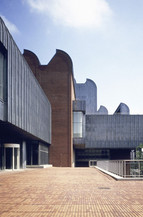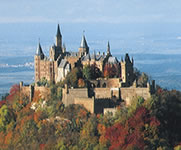Other highlights
Contact
KölnTourismus
Unter Fettenhennen 19
50667 Köln
Email:
info@koelntourismus.de
Internet:
www.koelntourismus.de
Unter Fettenhennen 19
50667 Köln
Email:
info@koelntourismus.de
Internet:
www.koelntourismus.de
Contact
Ausstellungs- und Messe-Ausschuss der Deutschen Wirtschaft e.V. (AUMA)
Littenstraße 9
10179 Berlin
Email:
info@auma.de
Internet:
www.auma-messen.de
Littenstraße 9
10179 Berlin
Email:
info@auma.de
Internet:
www.auma-messen.de
Museums

Located in the heart of the city, Cologne's Chocolate Museum is a veritable paradise for sweet-tooths and chocoholics. Its distinctive mascot, the North African character used to advertise Sarotti, is synonymous with high-quality chocolate in Germany. The museum has proved a hit with visitors thanks to the hand-on nature of its exhibitions. Guided tours explore the history of chocolate, from its origins as the "food of the Gods" in Aztec mythology to today's mass-produced million-sellers. Educational activities and special children's tours are available. The museum is closed on Mondays, carnival days, 24, 25 and 31 December and 1 January.
» Further information
Overlooked by majestic Cologne Cathedral, the Ludwig Museum houses a modern and contemporary art collection of international standing. On display are examples of Expressionism, art from 1920s Germany, the Russian avant garde and Surrealism. Picasso is well represented by an extensive collection of prints, sculptures and paintings, while pictures by Dali, Miró and Magritte are also on show. The Pop Art section features works by Roy Lichtenstein, Andy Warhol, Allen Jones and George Segal. Closed on Mondays. Guided tours available.
» www.museenkoeln.de/ludwig
The Wallraf Richartz Museum in Cologne is one of Germany's oldest and largest classical picture galleries. It houses the world's most extensive collection of medieval paintings, in particular works from Cologne's painting school, and an important collection of prints and drawings. Highlights of the collection include the Medieval gallery, which offers an insight into the development of Cologne's panel painting from 1300 to 1550, a selection of Renaissance art, the Baroque gallery with major works by artists such as Rubens and Rembrandt, and the 19th century gallery which includes paintings from the Romantic, Realist and Impressionist movements, as well as the Gérard J. Corboud collection and sculptures. The museum also has a number of exquisite miniatures on parchment, fascinating sketches and an extensive collection of prints and drawings comprising approx. 75,000 works of art. Closed on Mondays, guided tours on request.
» www.museenkoeln.de
The Roman-Germanic Museum, which opened in 1974, is next to the cathedral in Cologne and contains relics from the days when the Romans ruled the city. The museum presents the archaeological heritage of Cologne and the surrounding area, from prehistory through to the early Middle Ages. The museum's best-known exhibits include the Roman mosaic with scenes from the world of Dionysos (220/230 AD) and the reconstructed tomb of the legionary Poblicius (40 AD). Other highlights include the world's largest collection of Roman glassware and an outstanding collection of Roman and early medieval jewellery. Numerous exhibits detailing the everyday lives of the Romans take visitors back to the days of the Roman settlement known as Colonia Ara Agrippinensium. Closed on Mondays, guided tours on request.
» www.museenkoeln.de
Cologne Cathedral's priceless collection of treasures dates back as far as the 9th century. Since autumn 2000 its riches have been presented in newly designed exhibition space (approx. 500 m˛) in the extended 13th century vaulted cellars on the north side of the cathedral. Over 200 exquisite reliquaries, liturgical artefacts and vestments, archiepiscopal and cathedral clergy insignia from the 4th to the 20th century, medieval sculptures and Frankish grave finds can be seen in six rooms. St. Peter's staff and chains are among the most significant exhibits. Guided tours on request.
» www.koelnerdom.de
The Rautenstrauch-Joest Museum in Cologne has been providing an insight into the culture and art of non-European peoples since 1906. It has an extensive collection with a total of approx. 65,000 exhibits from India, Thailand, Tibet, Laos and Burma, as well as a comprehensive North American collection that includes a Pawnee Indian bear-claw necklace, eagle-feather head-dress and bison robe. The collection also includes 100,000 historical ethnographical photographs and a specialist library with 40,000 volumes. Closed on Mondays, guided tours available on request.
» www.koelntourismus.de
Founded in 1888, the Museum of Applied Art in Cologne is devoted to arts, crafts and design from the Middle Ages to the present day. On show are furniture and ceramics from the Middle Ages and the early modern period, textiles and jewellery. The focal points of the collection are European arts and crafts from the Middle Ages to the present day, glass (Italy 16th century, Germany 18th century, art nouveau), silver, pewter, jewellery (Gothic to present day), textiles (Gobelins, silk) and fashion (1800 to the present), 20th century design, posters and a collection of ornamental engravings. In special exhibitions the museum presents and discusses artists and developments across the applied arts spectrum, including the fields of architecture and fashion, photography, film and a range of interdisciplinary artistic approaches. Closed on Mondays. Guided tours available.
» www.museenkoeln.de
Opened in 1999, the Sport & Olympics Museum is one of Cologne's newest museums - a chance to experience sport at its best. With around 2,000m˛ of exhibition and interactive space on two floors, it offers a fascinating insight into the history and transformation of sport. Covering a whole range of sports, it depicts various aspects of national, international and Olympic sport in a permanent and temporary exhibition. The collection features 2,500 years of sports history, clothing, sports and games equipment, medals, certificates, sports awards, graphics, photos, videos and much more. Highlights include a cycle race in a wind tunnel, a boxing ring with sand bags and playing football on the highest sports pitch in Cologne. The sports studio depicts the beginnings of the media age and sporting highlights. Closed on Mondays, guided tours on request.
» www.sportmuseum.info
The Fragrance Museum in Cologne is located in the historical Farina House, where it all began. Now the oldest perfume factory in the world, its Eau de Cologne made the city famous in the 18th century, and the museum shows the beginnings and the history of perfume production. Eau de Cologne is the world's oldest perfume brand. Since 1709, royalty, the aristocracy and famous figures have been supplied with the special fragrance created by perfumer Johann Maria Farina. The three floors of the museum are dedicated to 300 years of fragrant culture. During a tour, those who want can inhale some of the exquisite scents. Closed on Sundays, guided tours by arrangement.
» www.farinahaus.de
This major collection of European medieval art was donated to the city in 1906 by Alexander Schnütgen (1843-1918), the canon of the cathedral. The museum is housed within the evocative surroundings of the Romanesque basilica of St Cecilia. Themed around the interplay of art and its surroundings, the collection showcases an array of religious art from the early Middle Ages to the baroque. These internationally acclaimed masterpieces span a period of 1,000 years. Here are just some of the items on display: ivory carvings, goldsmith work, wood and stone sculptures, bronze and silver art treasures, church furnishings, stained glass, manuscripts and fabrics – including liturgical robes and cloths from late antiquity to the 20th century. The city's proud display of ecclesiastical art from the Middle Ages represents one of the most important medieval collections in the world. Closed on Mondays.
» www.museenkoeln.de
Situated in the carnival capital of Cologne, this museum is the largest in the German-speaking world, and has set pulses racing since 2005. The origins of the city's famous street festival date back to ancient times, however the first modern incarnation was staged in 1823. In around 1,400m˛ of exhibition space, the Carnival Museum celebrates almost 200 years of fun and tradition. It documents the history and diversity of the event, from its ancient beginnings to the present day. The exhibition paints a vivid picture of what locals have dubbed "the fifth season of the year", covering everything from the street procession itself to the more alternative attractions. Highlights include the parade floats and their oversized effigies, costumed puppets and state-of-the-art audio-visual installations. One of the oldest exhibits is the carnival committee's protocol book from 1827. Closed Mondays, 24-26 and 31 Dec., 1 Jan., carnival days, Easter and Whitsun. Guided tours available.
» www.kk-museum.de
Anyone with a passion for culture is advised to visit Cologne's MediaPark, which has been home to one of Europe's very few museums of dance since 1997. The approx. 300m˛ of exhibition space features posters, prints and photos, tracing the history of stage and interpretive dance. Themes explored include: "From the Courtly Dance to the Romantic Ballet", "The Beginnings of Modern Dance" and "Dance in Cologne". Alongside the documents, materials and choreographic recordings you'd expect from a conventional library or archive, there are paintings, sculptures, etchings, artistic posters, authentic costumes, dance masks and much more besides. Open daily. Guided tours available.
» www.sk-kultur.de
Travel Planner
Select an option...
Map of Germany
Hotels in Cologne
Loading






